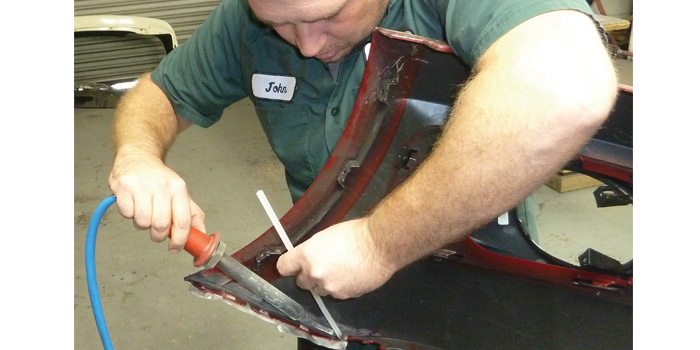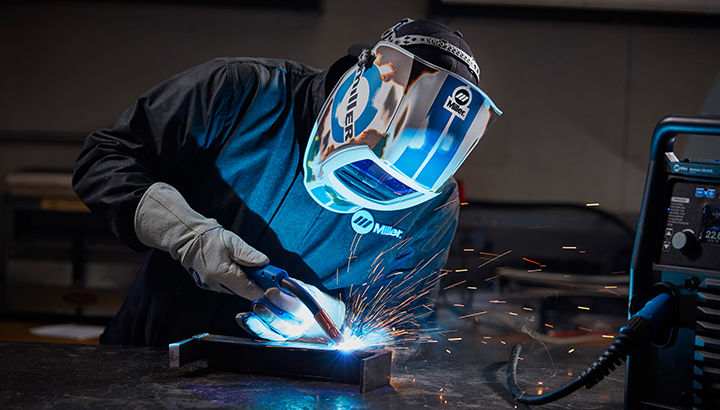Common Welding Repair Issues and Just How to Address Them Properly
Welding repairs often experience a variety of problems that can endanger the integrity of the end product. Usual problems consist of insufficient infiltration, porosity, and misalignment, amongst others. Each flaw provides unique obstacles that call for specific techniques for resolution. Recognizing these concerns is important for welders aiming to improve their skills and end results. This conversation will certainly explore these typical welding repair service concerns and effective methods to address them.
Inadequate Penetration
Inadequate penetration occurs when the weld metal stops working to totally fuse with the base product, resulting in weak joints and possible architectural failures. This issue often stems from not enough warmth input, wrong electrode angle, or improper welding speed. Welders may encounter inadequate penetration as a result of a mistake of the necessary specifications for a particular product thickness or kind. In addition, contamination on the base product's surface can prevent reliable bonding, intensifying the problem. To resolve insufficient penetration, welders ought to assure proper setups on their tools and preserve a clean work surface. Regular inspection of welds is recommended to recognize any deficiencies early, enabling prompt improvements and the prevention of endangered architectural stability in bonded settings up.
Porosity
Porosity is a common issue in welded joints that manifests as small gas bubbles trapped within the weld metal. This defect can endanger the stability of the weld, bring about minimized strength and possible failure under stress and anxiety. Belgrade Welding. Porosity typically arises from contamination, moisture, or incorrect welding techniques, which allow gases to get away into the liquified weld swimming pool. To deal with porosity, welders ought to assure correct surface prep work, preserve a clean workplace, and make use of appropriate welding criteria. In addition, selecting the best filler product and protecting gas can mitigate gas entrapment. Routine evaluation and testing of welds can help determine porosity early, guaranteeing prompt rehabilitative activities are taken, consequently maintaining the top quality and integrity of the welded framework
Imbalance
Imbalance in welding can emerge from different elements, consisting of improper setup and thermal development. Understanding the source is vital for effective resolution. A number of correction techniques are readily available to straighten elements and assure architectural integrity.
Reasons for Misalignment
Welding imbalance commonly stems from a selection of underlying concerns that can jeopardize architectural integrity. One main cause is improper fit-up of parts before welding, which can cause voids and unequal surface areas. Variations in thermal expansion throughout the welding process can also result in distortion, specifically if the products being signed up with have different coefficients of expansion. In addition, insufficient fixturing and securing might fall short to hold elements safely in position, bring about activity throughout welding. Poorly kept tools, consisting of welding machines and tools, may introduce disparities in the weld grain, further adding to misalignment. Finally, driver mistake, originating from not enough training or experience, can likewise play a considerable function in developing misaligned welds.
Correction Strategies Offered
Resolving misalignment efficiently requires a combination of restorative techniques customized to the certain issues available. One typical technique is the usage of jigs or fixtures to hold parts in the correct placement throughout welding, guaranteeing consistent positioning. In addition, preheating the materials can aid reduce distortion and improve fit-up. For considerable imbalance, mechanical realignment techniques, such as utilizing hydraulic jacks or clamps, can be utilized to correct the placement before welding. Post-weld warmth therapy may additionally be essential to relieve tensions triggered by imbalance. Ultimately, cautious examination and adjustment throughout the setup stage can protect against misalignment problems from coming to be considerable issues, promoting a smoother welding process and improving overall structural stability.
Distortion
Distortion is an usual obstacle in welding that can emerge from different variables, consisting of irregular heating & cooling. Comprehending the sources of distortion is important for applying effective avoidance methods. Resolving this issue not only boosts architectural honesty but likewise improves the overall high quality of the weld.
Reasons for Distortion
When subjected to the extreme warmth of welding, materials frequently go through changes that can cause distortion. This sensation mostly emerges from thermal expansion and contraction during the welding process. As the weld location warms up, the material broadens; upon air conditioning, it acquires, which can produce interior anxieties. Furthermore, irregular home heating across a work surface can intensify these stress and anxieties, resulting in warping or flexing. The kind of material likewise plays a considerable role; steels with differing thermal conductivity and coefficients of expansion might react in a different way, resulting in unforeseeable distortions. Inadequate joint design and inadequate fixturing can contribute to misalignment throughout welding, boosting the possibility of distortion. Comprehending these reasons is essential for effective welding repair service and prevention methods.
Prevention Techniques
Efficient prevention strategies for distortion throughout welding concentrate on managing warmth input and guaranteeing appropriate joint layout. Maintaining a constant warmth input aids to lessen thermal expansion and tightening, which can lead to distortion. Making use of strategies such as preheating the work surface can also decrease the temperature level gradient, promoting uniform heating. Furthermore, selecting appropriate joint layouts, such as T-joints or lap joints, can boost security and minimize anxiety concentrations. Executing correct fixturing to safeguard the work surfaces in location further help in maintaining alignment throughout the welding process. Ultimately, staggered welding sequences can distribute heat a lot more equally, stopping localized distortion. By using these strategies, welders can greatly decrease the probability of distortion and enhance the total quality of their welds.
Breaking
Fracturing is a common concern experienced in welding fixings, commonly resulting from different variables such as inappropriate air conditioning prices, product choice, or poor joint preparation. The event of splits can substantially endanger the honesty of the weld, causing prospective failures throughout operation. To address this concern, welders need to first analyze the source, ensuring that materials work and appropriately picked for the certain application. In addition, controlling the air conditioning price throughout the welding process is necessary; rapid cooling can generate stress and cause breaking. Proper joint layout and prep work also add to reducing the risk. Applying these methods can boost weld top quality and toughness, inevitably decreasing the probability of breaking in ended up weldments.

Incomplete Blend
A substantial concern in welding fixings is insufficient blend, which occurs when the weld metal does not effectively bond with the base material or previous weld passes - Montana Mobile Welding and Repair Belgrade. This problem can my review here bring about weaknesses in the joint, potentially endangering the integrity of the welded structure. Aspects adding to insufficient fusion include not enough warmth input, incorrect welding technique, and contamination of the surface areas being joined. To resolve this issue effectively, welders should guarantee correct pre-weld cleaning and surface area preparation, news along with change their welding criteria to achieve ample penetration and fusion. Normal inspection during the welding process can also help recognize insufficient combination early, enabling prompt rehabilitative steps to enhance the general top quality of the weld
Overheating
While welding fixings can improve architectural stability, overheating presents a significant obstacle that can bring about material degradation. Extreme warm during welding can alter the mechanical buildings of metals, leading to lowered strength, enhanced brittleness, and bending. This phenomenon is particularly important in high-stress applications where architectural dependability is paramount. Recognizing getting too hot can include aesthetic examinations for staining or distortion, along with checking temperature level during the welding process. To mitigate the risks associated with overheating, welders should employ suitable strategies, such as controlling warmth input, adjusting travel speed, and using ideal filler materials. In addition, implementing pre- and post-weld warmth therapies can help restore material homes and improve the total top quality of the fixing, making sure long-lasting performance and security.
Frequently Asked Inquiries
What Are the Common Signs of a Welding Flaw?

Exactly How Can I Test My Welds for High quality?
To examine welds for high quality, one can utilize visual assessments, ultrasonic testing, and radiographic methods. Each method assures structural honesty, recognizes defects, and confirms adherence to defined criteria, eventually enhancing the dependability of the bonded joints.
What Safety and security Preventative Measures Should I Take While Welding?
When welding, one ought to focus on safety and security by putting on appropriate individual protective equipment, ensuring proper ventilation, safeguarding flammable materials away, preserving a tidy office, and being conscious of environments to stop injuries and crashes.
Can I Fix a Weld Without Redesigning the Entire Joint?
Repairing a weld without remodeling the whole joint is possible, relying on the damage (Belgrade Fabrication). Techniques such as grinding, adding filler product, or utilizing a welding procedure can successfully address particular defects while maintaining the surrounding framework
What Equipment Are Important for Reliable Welding Repair Works?
Essential devices for effective welding repair services include a welding equipment, cord brush, grinder, protective gear, clamps, and filler materials. Each device plays a vital role in guaranteeing high quality and safety during the repair process. Porosity usually arises from contamination, wetness, or inappropriate welding techniques, which allow gases to escape right into the molten weld swimming pool. Poorly conserved devices, consisting of welding equipments and tools, might present incongruities in the weld bead, more adding to misalignment. When subjected to the intense warm of welding, materials often go through adjustments that can lead to distortion. Breaking is a typical concern run into in welding repair services, usually resulting from various elements such as incorrect cooling prices, product selection, or insufficient joint preparation. A substantial concern in welding fixings is insufficient combination, which occurs visit homepage when the weld steel does not adequately bond with the base material or previous weld passes.